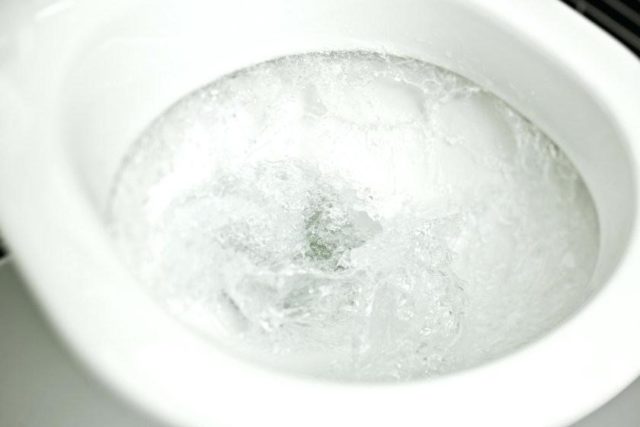Content
- 1 Features of cleaning the toilet bowl from lime deposits
- 2 How to remove limestone in the toilet using folk methods
- 2.1 How to clean limescale in the toilet with citric acid
- 2.2 How to remove limescale from the toilet with vinegar
- 2.3 How to clean a toilet bowl from limescale with oxalic acid
- 2.4 How to get rid of limescale in the toilet with baking soda
- 2.5 How to clean old limescale from a toilet with cola
- 2.6 How to clean a toilet bowl from limescale deposits with whiteness
- 2.7 How to remove limestone in the toilet with electrolyte
- 3 How to remove limescale deposits in the toilet with specialized products
- 4 Preventing the appearance of limescale in the toilet
- 5 Conclusion
It is possible to remove limescale in the toilet, even if the deposits have accumulated for a very long time. For cleaning, not only chemicals are suitable, but also household substances, they are present in almost any kitchen or pantry.
Features of cleaning the toilet bowl from lime deposits
Any toilet bowl in the absence of careful maintenance over time becomes covered with limescale. This plaque is formed from mineral salts present both in human urine and in tap water. Since the bowl remains constantly damp, a strong stone is formed quickly. Solid deposits on its surface first appear as a thin film, and then turn into a real yellowish build-up if they are not removed in time.
When cleaning the toilet from plaque, several features must be considered:
- The plumbing bowl should be cleaned with an ordinary brush, a medium-hard brush or a sponge with an abrasive dense side. Metal washcloths and toilet scrapers cannot be used, they will leave microscopic scratches on the surface of the bowl, and plaque will accumulate on the walls even faster.
- When cleaning the toilet bowl, water from the plumbing fixture must be pumped out to the maximum, if possible, even from the drain hole with a ladle. In this case, the cleaning agents will be more effective and will help remove deposits faster, since the water will not weaken their concentration.
- When using aggressive acids and alkalis, it is necessary to keep them on the walls of the bowl for no longer than the specified time. If left on for a long time, harsh cleaning agents can damage the enamel of the fixture. After that, limescale deposits will start to appear faster and become more difficult to remove.
In the process of removing limescale from the toilet, it is imperative to use gloves and a protective mask so as not to inhale toxic vapors of chemicals and not injure the skin and mucous membranes. After cleaning, the plumbing must be washed with clean water several times, all residues of household and chemical products must be completely removed.

How to remove limestone in the toilet using folk methods
If a strong stone has formed in the plumbing bowl, then you can remove it with simple means for removing limescale in the toilet. They show a good effect against both light deposits and heavy soiling. At the same time, household substances, unlike specialized chemicals, are not at all expensive.
How to clean limescale in the toilet with citric acid
You can use citric acid not only in cooking, but also for cleaning plumbing.With a strong stone, it is enough to sprinkle the contaminated walls of the bowl with powdered acid and leave for 3 hours.
After the expiration date, citric acid must be removed with a damp sponge, and with it, hard deposits will be removed. After such cleaning, the plumbing must be thoroughly rinsed twice.
How to remove limescale from the toilet with vinegar
Another good remedy for removing deposits is regular 9% table vinegar. Before you clean the toilet bowl from strong limestone, you need to warm vinegar in the amount of 1 cup to a warm temperature, and then add 1 large spoonful of soda to it.
The compound agent is applied to the inner walls of the toilet bowl in the evening and left overnight. In the morning, you only need to drain the water several times and lightly walk over the bowl with a brush to remove dirt. Vinegar and baking soda can help remove limestone with little or no effort.

How to clean a toilet bowl from limescale with oxalic acid
Oxalic acid, which is similar in properties to citric acid, helps well to remove hard plaque from the walls of the toilet. To clean the plumbing, sprinkle generously with acid on the abrasive side of the sponge, and then rub the earthenware bowl thoroughly for several minutes. The remains of oxalic powder are thoroughly washed off, while the gray and yellow stone can be removed without a trace.
How to get rid of limescale in the toilet with baking soda
One of the best solutions for limescale in the toilet is baking soda. To remove dirt in the toilet, it is necessary to dilute the entire pack of soda in a small amount of water - until a homogeneous semi-liquid gruel is obtained. The mixture is evenly distributed over the inner surface of the sanitary bowl overnight, and in the morning the faience is rubbed with a brush and washed off.
If the plaque is old and tough, the baking soda can be mixed with a few large tablespoons of vinegar. The tool, consisting of two aggressive components at once, will be doubly effective and will help to remove the stone that has grown on the walls of the plumbing.
How to clean old limescale from a toilet with cola
Reviews of limescale on the rim of the toilet say that the famous "Coca-Cola" is not only suitable for food use - it is an excellent cleaning agent that helps to quickly remove solid dirt. Cola is used for cleaning very simply - a faience bowl is poured over the rim with a brown drink and left for 1 hour.
After that, the inside of the plumbing bowl is wiped with a sponge and the water is drained several times. "Cola" helps to remove even strong solid dirt without leaving a trace. It is curious that the carbonated drink with such amazing properties remains quite safe for food consumption, the acidic environment of the stomach is much more aggressive in composition than "Cola".
How to clean a toilet bowl from limescale deposits with whiteness
The whitening product with the expressive name Whiteness fights not only tough stains, but also hard dirt on the surface of plumbing. To remove hard and durable deposits with Whiteness, dry the bowl as much as possible with rags or paper napkins, and then pour plenty of bleach along the rim line.
Whiteness will bring maximum effect if left on the walls of the bowl for 8-12 hours. After the specified time has elapsed, the walls of the bowl are treated with a brush or sponge, and then the water is washed off several times in a row to remove dirt and bleach residues.

How to remove limestone in the toilet with electrolyte
If the strong limescale in the toilet is very old, and there are simply no other strong remedies at hand, you can remove the electrolyte contamination. But it should be borne in mind that the composition contains sulfuric acid, and on the one hand, it makes the electrolyte extremely effective, and on the other, increases its danger. It is necessary to handle the liquid only with thick rubber gloves and a mask, it is impossible to allow the product to get on your hands, it is also dangerous to inhale its vapors.
The electrolyte is used like this - a small amount of the product is applied with a sponge to the inner surface of the plumbing, and then the lid is immediately closed. Keep the product for no more than 15 minutes, after which the water is drained several times in a row, the lid is still kept closed. In no case should the product get on the seat; it must be used very carefully.
How to remove limescale deposits in the toilet with specialized products
Sometimes, home remedies for tough deposits may not be on hand. In addition, not everyone is willing to carefully measure out the proportions of baking soda or vinegar for cleaning. In this case, you can purchase one of the specialized products - they show good efficiency and help to easily remove stone deposits.
In general, plumbing chemicals can be divided into several categories:
- Acidic... These include Dressing Duck, Sanox and other gels with a rather aggressive composition. They work best against old limescale, but you need to work with them very carefully, protecting your face and hands. Acid gels should not be kept on the enamel for too long, they can damage the surface.

- Alkaline... Domestos, Bref, Dosya belong to this category - alkaline agents pose less danger to humans and plumbing than acidic ones, but their effectiveness is slightly lower. Best of all, alkaline gels help remove fresh plaque that has not yet had time to properly adhere to the surface.

- Chlorine... Products with a high percentage of chlorine in the composition, such as Comet or Titan, are suitable for regular and preventive cleaning. They cope well with plaque, but they leave behind an unpleasant odor. The toilet after them must be thoroughly ventilated, and when cleaning, use a mask so as not to inhale chlorine vapors.
 It is better to clean plumbing with gel products, rather than abrasive powders.
It is better to clean plumbing with gel products, rather than abrasive powders.
Preventing the appearance of limescale in the toilet
The easiest way to protect plumbing from the appearance of lime deposits is with the help of timely prevention. To keep the toilet clean and fresh, we recommend:
- clean the inside of the plumbing fixture with household or industrial chemicals weekly, it takes little time, and no limescale builds up on the walls of the bowl;
- use a brush after each trip to the toilet for emergency cleaning of the walls;
- timely repair the drain tank if water leaks in it, the liquid constantly flowing along the walls of the faience bowl accelerates the appearance of plaque;
- use special cassettes and tablets that soften and purify water, they are designed not only to flavor the restroom, but also to protect plumbing from limescale deposits;
- clean the plumbing only with a special brush, sponge or soft brushes without using hard abrasive tools - a scratched faience surface is covered with plaque faster.
It is not recommended to pour the remnants of fatty and hot food into the sewer - a thin film forms on the walls of the plumbing, contributing to the appearance of plaque. If the plumbing is still used to dispose of food waste, then each time it must be immediately cleaned with a brush and drained twice.

Conclusion
Removing limescale in the toilet is not so difficult, even if the plumbing has not been cleaned for a long time, and dense deposits have formed inside. Household and special products quickly help remove limestone, but it is best to wash the toilet prophylactically at least once a week, then it will be easier to take care of it.

